K. C. Heald (1916) applied the name Foraker Formation to rocks that are exposed in the vicinity of Foraker, Osage County, Oklahoma. In its type locality, the Foraker Formation is about 75 feet (23 m) thick but the Foraker is only about 40 feet (12 m) thick in southeastern Nebraska. The Foraker Formation has three members, in ascending order: The Americus Limeston, the Hughes Creek Shale, and the Long Creek Limestone.
M. Z. Kirk (1896) named the Americus Limestone for the village of Americus, Lyon County, Kansas, where it is about 7 feet (2.6 m) thick. In southeastern Nebraska, the Americus Limestone is usually only about 2 feet (0.7 m) thick. It is usually dense, finely crystalline, fossiliferous, and may be the transgressive limestone of a cyclothem. The Americus Limestone may have three to five beds that are separated by thin shale seams in the southeastern Nebraska outcrop area. The Americus Limestone heralds the return in the midcontinent of sedimentation patterns that were more similar to those observed in the older (late Pennsylvanian) Missouri and early Virgil series.
G. E. Condra, 1927, originally applied the name Hughes Creek Shale to up to 50 feet (16 m) of blue, clayes shale, dark shale and thin limestone beds for Hughes Creek, south of Auburn, in Nemaha County, Nebraska. Subsequent workers (Moore and Condra, 1932; Condra, 1935, Moore, 1936, and Burchett) revised the Hughes Creek Shale and beds now called the Oaks Shale, the Houchens Creek Limestone, and Stine Shale were removed from the lower part of the Hughes Creek.
Condra (1927) named the Long Creek Limestone for the beds that immediately overlie the Hughes Creek Shale for cavernous (vuggy?), irregular beds that are exposed on Longs Creek at the foot of the bluff west of the cemetery at Auburn, Nemaha County, Nebraska.
Holterhoff and Pabian (1990), Pabian and Boardman (1995), and Pabian and Diffendal (1989, 1991, in press) recorded several outcrops of the Foraker Formation in Richardson and Pawnee counties.
Pioneer geologists such as F. B. Meek, F. V. Hayden, J. Marcou, and H. B. Geinitz who worked in Nebraska in the 1850's and 1860's first described many of the fossils that are illustrated below.
Many morpholgic terms are used in describing the fossils below. You are referred to any standard text book on invertebrate paleontology to see how these features relate to the body of the living or fossil animal.
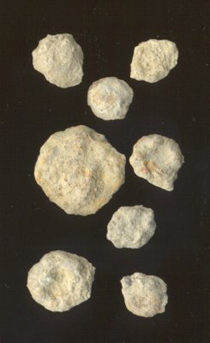
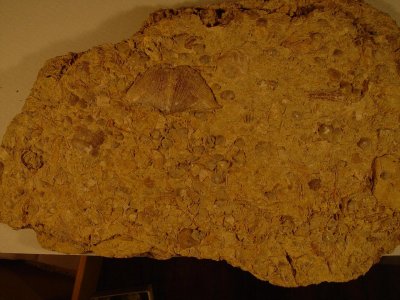
Slab of Fossiliferous Limestone
Description: This slab of fossiliferous limestone from the upper part of the Hughes Creek Shale Member of the Foraker Formation contains more than 20 different fossil species. Such fossils document the abundance and diversity of life forms in the seas that covered southeastern Nebraska and most of the North American Midcontinent during the Early Permian.
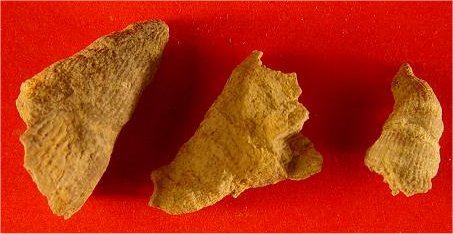
Lophamplexus sp. cf. L. eliasi
Description: "?Lophamplexus sp. cf. L. eliasi" Moore and Jeffords. Lophophylloid corals are relatively scarce in the Hughes Creek shale. These specimens are tentatively assigned to Lophamplexus eliasi because of their resemblance to the illustrated type specimens, some of which were collected from the Foraker Formation in Kansas and Oklahoma. The Nebraska examples were collected in Richardson County from the regressive upper part of the Hughes Creek Shale where shallow, warm water environments existed when these sediments were deposited. The polyp (living coral animal) has tentacles equipped with stinging cells that surround a centrally located mouth and it lived in the depression at the top of the conical corallite. The "corallite" or stony skeleton has horizontal dividers called "tabulae" and vertical dividers called "septa" that may converge in the center to form a columella.
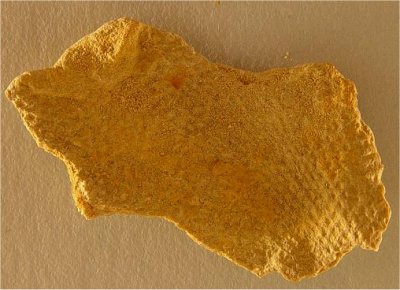
Septopora sp. cf. S. conradi
Description: "Septopora sp. cf. S. conradi" Condra. Part of frond showing fenestrate or window-like morphology. Note that the large, window-like structures are not the zooecia. The zooecia are tiny pores that cover the solid parts of the zooarium and magnification of about 5 power is needed to observe them clearly. Fenestrate ectoprocts attach to the substrate by a holdfast-like structure.
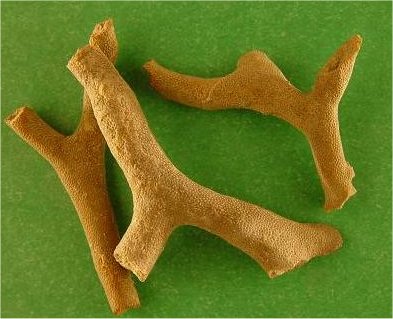
Rhombopora lepidodendroides
Description: "Rhombopora lepidodendroides" (Meek). The genus "Rhombopora" derives its name from the rhombus or diamond-shaped zooecia openings. This species "lepidodendroides" derives its’ name from the fact that its zooaria resemble a miniature "Lepidodendron", a fossil-stem genus of a tree-like plant that is related to the modern day lycopod. Branching ectoprocts usually attach to the substrate by a holdfast-like structure. "Rhombopora" superficially is similar to "Thamniscus" but the former branches but slightly and usually only in a single plane.
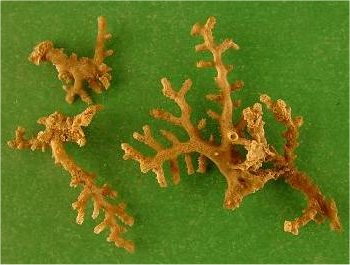
Thamniscus pinnatus
Description: "Thamniscus pinnatus" Condra differs from "Rhombopora" and other branching ectoprocts inasmuch as a zooarium will show numerous branches that extend in many directions.
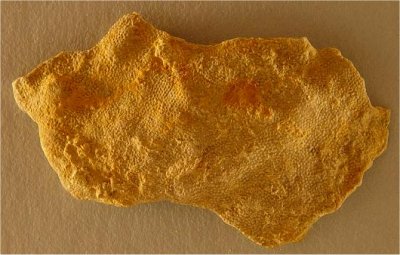
Cyclotrypa barberi
Description: "Cyclotrypa barberi." Ulrich is characterized by massive zooaria that are usually elliptical in cross section, and up to 10 to 12 mm in diameter, compared to "Rhombopora" which is round in Cross section and only has diameters of about 2 to 3 mm.
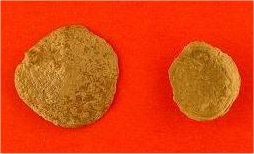
Crania modesta
Description: "Crania modesta" White and St. John. These examples of "Crania modesta" are unusual inasmuch as they are not attached to any other organism. In older rocks of late Pennsylvanian (Missourian) age, "C. modesta" is commonly attached to other invertebrates, by the time that the Hughes Creek Shale was deposited, "C. modesta" is found almost exclusively attached to the pedicle valves of the large productoid brachiopod, Reticulatia huecoensis (King).
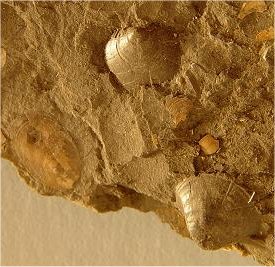
Orbiculoidea missouriensis
Description: "Orbiculoidea missouriensis" (Shumard) is a coolie cap-shaped brachiopod that is commonly found in dark gray to black, fissile (platy) shale that probably represents deep, dysaerobic water and represents the point of maximum transgression of the seaway. Often the only macro-fossils that are contained in such shale are either "O. missouriensis" or "Lingula carbonaria". "O. missouriensis" has a slit-like pedicle opening.
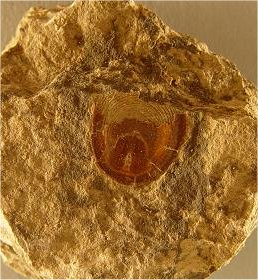
Lingula carbonaria
Description: "Lingula carbonaria" Swallow is a tear-drop shaped inarticulate brachiopod that is common in black shale facies that represent deep, cold dysaerobic water. In addition to "Orbiculoidea missouriensis", "L. carbonaria" is found with microfossils called conodonts.
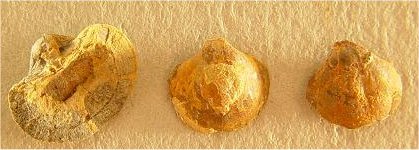
Crurithyris planoconvexa
Description: Two views of "Crurithyris planoconvexa" (Shumard) showing brachial valve (left) and two pedicle valves. "C. planoconvexa" is one species of brachiopod that is commonly found associated with bivalves. "C. planoconvexa" is commonly found in the offshore, dysaerobic environments where a diverse bivalve fauna is found, and it is usually the only species of brachiopod observed there. Rudwick (1965) has suggested that brachiopods with deeply plano-convex shells may have lived with convex shell pressed into the soft substrate. Mudge and Yochelson (1962) stated that the related species "C. expansa" (Dunbar & Condra) preferred argillaceous (clayey) environments, were commonly found in thin layers immediately above or unfossiliferous beds, and rarely carried any epifauna. Holterhoff and Pabian (1989) found "C. planoconvexa" to be the only species of brachiopod in the dysaerobic facies of the Hughes Creek Shale, a unit they mistakenly called the Bennett Shale.
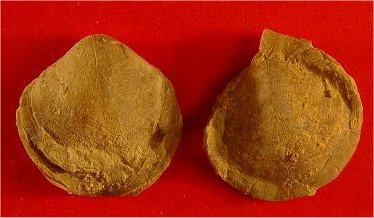
Composita subtilita
Description: "Composita subtilita" (Hall), pedicle and brachial valves. "Composita subtilita" (Hall) is one of the most common brachiopods in the late Pennsylvanian and early Permian rocks of Nebraska. The genus "Composita" is difficult to separate into species and this problem was discussed by Mudge and Yochelson (1962) and Lutz-Garihan (1976). Dunbar and Condra (1932) based "C. subtilita" and "C. ovata" Mather on differences in juvenile brachiopods and stated that these differences merged in adults. Lutz-Garihan (1976) recognized two distinct morphotypes as end member of a gradational series and that the end members did not differ significantly and called these all intraspecific variants.
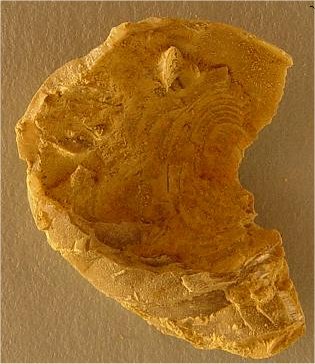
Composita subtilita
Description: "Composita subtilita" (Hall) showing spiralia on inside of pedicle valve. Spiralia, the coil-like lophophore supports, are rarely preserved in fossil brachiopods.
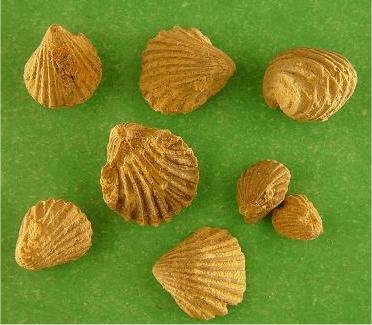
Hustedia mormoni
Description: "Hustedia mormoni" (Marcou) showing pedicle opening on large shell in center. The species "Hustedia mormoni" (Marcou) 1858 was one of the first invertebrate fossils described from what is now known as Nebraska. Marcou originally described this species as "Terebratula Mormoni" Marcou in his Geology of North America. Note that Marcou’s name appears outside of parentheses in the original description. When the species was moved to another genus, Hustedia, the species’ author’s name was placed in parentheses. This is a taxonomic practice. Marcou was a French Geologist who made the first bedrock map of what is now Nebraska. He was hired by Secretary of Interior, Jefferson Davis, who later became President of the Confederate States of America. Marcou left the United States at the outbreak of hostilities between the Confederacy and Union and eventually published his material from memory. His works proved to be quite accurate.
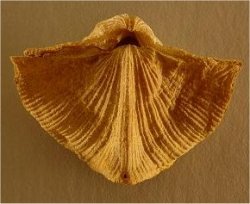
Neospirifer sp. cf. N. kansasensis
Description: "Neospirifer" sp. cf. N. "kansasensis" (Swallow). Mudge and Yochelson (1962) assigned most of the Neospirifers from the Hughes Creek Shale in Kansas to N. dunbari R. E. King, and they based this on the number of plications in the fold of the pedicle valve. Dunbar and Condra (1932) stated that N. kansasensis had 18 to 20 plications in the fold on the pedicle valve. It is interesting that most of the Neospirifers in the Nebraska Geological Survey’s invertebrate paleontological collections, many of which were collected by Dunbar and Condra, carry the label Neospirifer kansasensis. The identification made by Dunbar and Condra is being retained here, but the large sample has never been systematically analyzed. Mudge and Yochelson (1962) pointed out that most specimens of N. dunbari were pedicle valves. A census of 283 specimens of N. kansasensis from about 20 different localities in Nebraska and Kansas revelaed 239 pedicle valves, 20 brachial valves, and 24 complete specimens. This brings to light a very important question: Where have all of the brachial valves gone? Were they selectively washed away by currents? Did some predator attack Neospirifer through the usually thinner brachial valve? Do the collections simply show collecting bias? Many questions can be brought to light by even a cursory examination of large samples.
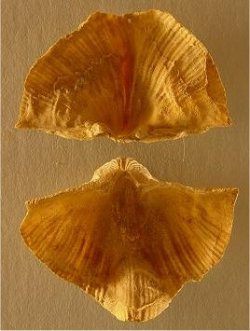
Neospirifer sp. cf. N. kansasensis
Description: "Neospirifer" sp. cf. N. "kansasensis" (Swallow). Mudge and Yochelson (1962) assigned most of the Neospirifers from the Hughes Creek Shale in Kansas to N. dunbari R. E. King, and they based this on the number of plications in the fold of the pedicle valve. Dunbar and Condra (1932) stated that N. kansasensis had 18 to 20 plications in the fold on the pedicle valve. It is interesting that most of the Neospirifers in the Nebraska Geological Survey’s invertebrate paleontological collections, many of which were collected by Dunbar and Condra, carry the label Neospirifer kansasensis. The identification made by Dunbar and Condra is being retained here, but the large sample has never been systematically analyzed. Mudge and Yochelson (1962) pointed out that most specimens of N. dunbari were pedicle valves. A census of 283 specimens of N. kansasensis from about 20 different localities in Nebraska and Kansas revelaed 239 pedicle valves, 20 brachial valves, and 24 complete specimens. This brings to light a very important question: Where have all of the brachial valves gone? Were they selectively washed away by currents? Did some predator attack Neospirifer through the usually thinner brachial valve? Do the collections simply show collecting bias? Many questions can be brought to light by even a cursory examination of large samples.
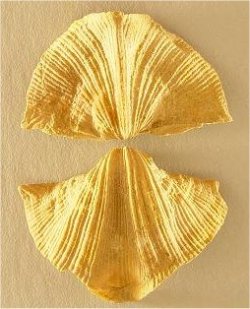
Neospirifer sp. cf. N. kansasensis
Description: "Neospirifer" sp. cf. N. "kansasensis" (Swallow). Mudge and Yochelson (1962) assigned most of the Neospirifers from the Hughes Creek Shale in Kansas to N. dunbari R. E. King, and they based this on the number of plications in the fold of the pedicle valve. Dunbar and Condra (1932) stated that N. kansasensis had 18 to 20 plications in the fold on the pedicle valve. It is interesting that most of the Neospirifers in the Nebraska Geological Survey’s invertebrate paleontological collections, many of which were collected by Dunbar and Condra, carry the label Neospirifer kansasensis. The identification made by Dunbar and Condra is being retained here, but the large sample has never been systematically analyzed. Mudge and Yochelson (1962) pointed out that most specimens of N. dunbari were pedicle valves. A census of 283 specimens of N. kansasensis from about 20 different localities in Nebraska and Kansas revelaed 239 pedicle valves, 20 brachial valves, and 24 complete specimens. This brings to light a very important question: Where have all of the brachial valves gone? Were they selectively washed away by currents? Did some predator attack Neospirifer through the usually thinner brachial valve? Do the collections simply show collecting bias? Many questions can be brought to light by even a cursory examination of large samples.
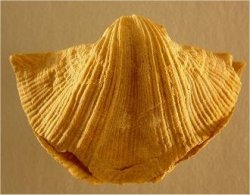
Neospirifer sp. cf. N. kansasensis
Description: "Neospirifer" sp. cf. N. "kansasensis" (Swallow). Mudge and Yochelson (1962) assigned most of the Neospirifers from the Hughes Creek Shale in Kansas to N. dunbari R. E. King, and they based this on the number of plications in the fold of the pedicle valve. Dunbar and Condra (1932) stated that N. kansasensis had 18 to 20 plications in the fold on the pedicle valve. It is interesting that most of the Neospirifers in the Nebraska Geological Survey’s invertebrate paleontological collections, many of which were collected by Dunbar and Condra, carry the label Neospirifer kansasensis. The identification made by Dunbar and Condra is being retained here, but the large sample has never been systematically analyzed. Mudge and Yochelson (1962) pointed out that most specimens of N. dunbari were pedicle valves. A census of 283 specimens of N. kansasensis from about 20 different localities in Nebraska and Kansas revelaed 239 pedicle valves, 20 brachial valves, and 24 complete specimens. This brings to light a very important question: Where have all of the brachial valves gone? Were they selectively washed away by currents? Did some predator attack Neospirifer through the usually thinner brachial valve? Do the collections simply show collecting bias? Many questions can be brought to light by even a cursory examination of large samples.
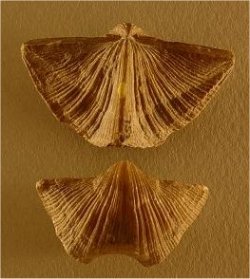
Neospirifer sp. cf. N. kansasensis
Description: "Neospirifer" sp. cf. N. "kansasensis" (Swallow). Mudge and Yochelson (1962) assigned most of the Neospirifers from the Hughes Creek Shale in Kansas to N. dunbari R. E. King, and they based this on the number of plications in the fold of the pedicle valve. Dunbar and Condra (1932) stated that N. kansasensis had 18 to 20 plications in the fold on the pedicle valve. It is interesting that most of the Neospirifers in the Nebraska Geological Survey’s invertebrate paleontological collections, many of which were collected by Dunbar and Condra, carry the label Neospirifer kansasensis. The identification made by Dunbar and Condra is being retained here, but the large sample has never been systematically analyzed. Mudge and Yochelson (1962) pointed out that most specimens of N. dunbari were pedicle valves. A census of 283 specimens of N. kansasensis from about 20 different localities in Nebraska and Kansas revelaed 239 pedicle valves, 20 brachial valves, and 24 complete specimens. This brings to light a very important question: Where have all of the brachial valves gone? Were they selectively washed away by currents? Did some predator attack Neospirifer through the usually thinner brachial valve? Do the collections simply show collecting bias? Many questions can be brought to light by even a cursory examination of large samples.
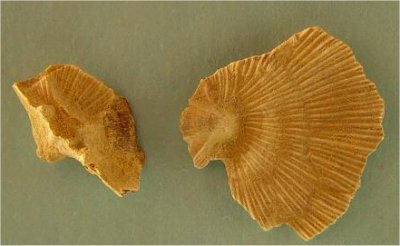
Derbyia crassa
Description: This example of "Derbyia crassa" (Meek and Hayden) was collected from the transgressive, deep, cold water, dysaerobic (oxygen deficient) facies of the lower Hughes Creek Shale in Richardson County. Note that it has a small thin, etched shell. Mudge and Yochelson (1962) stated that "Derbyia crassa" specimens that were collected from calcareous shale tended to be small. Diameter of large shell is about ¾ in (18 mm).
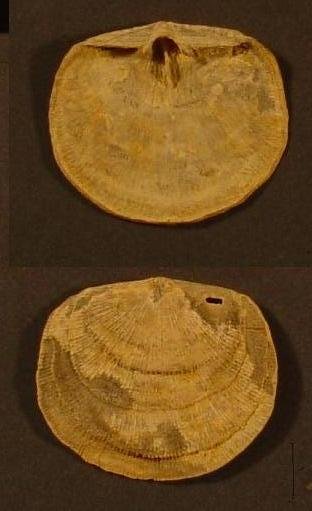
Derbyia crassa
Description: These are interior and exterior views of the pedicle valve of "Derbyia crassa" (Meek and Hayden). This example was collected from the regressive, shallow, warm water, aerobic (well-oxygenated) facies of the upper Hughes Creek Shale. Note that it has a thick, robust shell. Diameter of shell is about 2.0 in (50 mm). "D. crass" is characterized by having a rather flat shell comapred to all of the other species in this genus. Mudge and Yochelson (1962) also observed that "D. crassa" from Kansas usually carries no epifauna and the Nebraska specimens also bear this out.
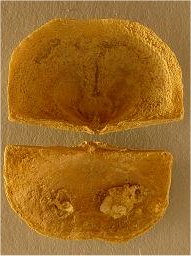
Neochonetes granulifer
Description: "Neochonetes granulifer" (Owen) is probably the most common brachiopod in the Hughes Creek Shale. In some outcrops, it may make up more than 50 percent of the macro-fauna. It is more common in the upper part of the Hughes Creek and replaces many of the large productoid and strophomenoid brachiopods that are more common in the lower parts of the Hughes Creek. Both Dunbar and Condra (1932) and Mudge and Yochelson (1962) recorded thick- and thin-shelled forms of this species. All from the Hughes Creek Shale in Nebraska studied here are thin-shelled forms. Thick-shelled forms have been found in the Florena Shale Member of the Beattie Formation in Nebraska.
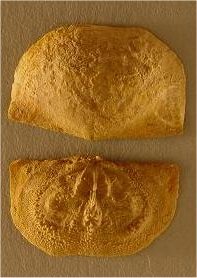
Neochonetes granulifer
Description: "Neochonetes granulifer" (Owen) is probably the most common brachiopod in the Hughes Creek Shale. In some outcrops, it may make up more than 50 percent of the macro-fauna. It is more common in the upper part of the Hughes Creek and replaces many of the large productoid and strophomenoid brachiopods that are more common in the lower parts of the Hughes Creek. Both Dunbar and Condra (1932) and Mudge and Yochelson (1962) recorded thick- and thin-shelled forms of this species. All from the Hughes Creek Shale in Nebraska studied here are thin-shelled forms. Thick-shelled forms have been found in the Florena Shale Member of the Beattie Formation in Nebraska.
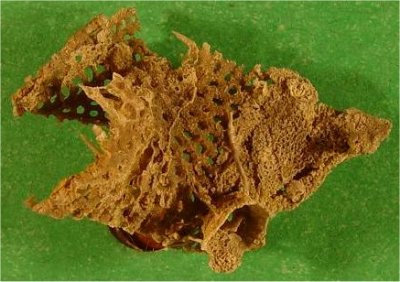
Hystriculina hystricula
Description: "Hystriculina hystricula" (Dunbar & Condra) on "Thamniscus" sp. This is a splendid example of a productoid brachiopod "Hystriculina hystricula" (Dunbar & Condra) attached to a frond of ectoprocts. These examples are from the regressive facies of the Hughes Creek Shale.
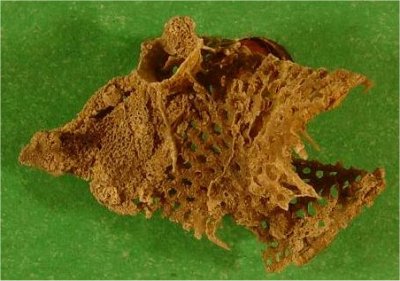
Hystriculina hystricula
Description: "Hystriculina hystricula" (Dunbar & Condra) on "Thamniscus" sp. This is a splendid example of a productoid brachiopod "Hystriculina hystricula" (Dunbar & Condra) attached to a frond of ectoprocts. These examples are from the regressive facies of the Hughes Creek Shale.
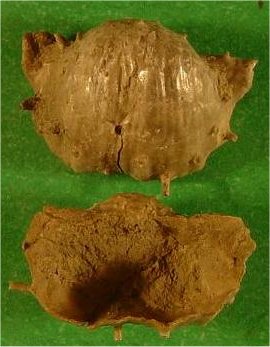
Hystriculina hystricula
Description: Pedicle and brachial valves of "Hystriculina hystricula" (Dunbar & Condra); note the robust spine terminations on pedicle valve. These examples are from the regressive facies of the Hughes Creek Shale.
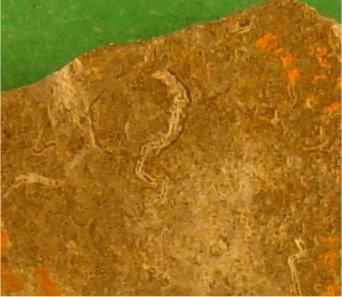
Leptolosia ovalis
Description: "Leptolosia ovalis" Dunbar and Condra is a very small species of productoid brachiopod. Further research may show that it is an immature example of previously described, larger species. Leptolosia is commonly found attached to other fossils. Specimens in the Nebraska Geological Survey collections show that "l. ovalis" is a long ranging species. It Is commonly attached to other productoid brachiopods. Pabian and Rushlau (2002) figured an example attached to a crinoid cup, and White and St. John (1867) and Dunbar and Condra (1932) have shown examples of other species of this genus attached to chaetetids and corals.
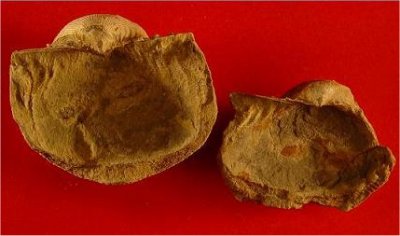
Linoproductus magnispinus
Description: "Linoproductus magnispinus" (Dunbar & Condra). The two shells show brachial and pedicle valves of "Linoproductus magnispinus" Dunbar & Condra. "L. magnispinus" is closely related to "L. prattenianus" (Norwood & Pratten); the former species has fewer, larger spines on the pedicle valve. Dunbar and Condra collected their type specimens of "L. magnispinus" from the Hughes Creek Shale in Lancaster and Nemaha counties. Dunbar and Condra (1932) also stated that in the horizon from which the types were collected, this species was so abundant that it formed shelly bands that extended from southeastern Nebraska to Oklahoma.
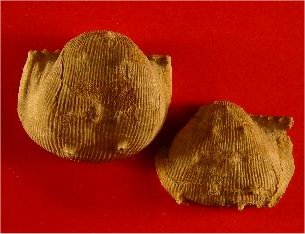
Linoproductus magnispinus
Description: "Linoproductus magnispinus" (Dunbar & Condra). The two shells show brachial and pedicle valves of "Linoproductus magnispinus" Dunbar & Condra. "L. magnispinus" is closely related to "L. prattenianus" (Norwood & Pratten); the former species has fewer, larger spines on the pedicle valve. Dunbar and Condra collected their type specimens of "L. magnispinus" from the Hughes Creek Shale in Lancaster and Nemaha counties. Dunbar and Condra (1932) also stated that in the horizon from which the types were collected, this species was so abundant that it formed shelly bands that extended from southeastern Nebraska to Oklahoma.
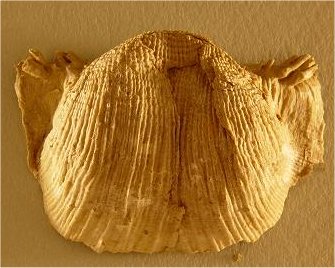
Reticulatia huecoensis
Description: "Reticulatia huecoensis" (R. E. King). This image shows the pedicle and brachial valves and the interior of a brachial valve of "Reticulatia huecoensis" (R. E. King). This species has been found in several outcrops of Hughes Creek Shale in southeastern Nebraska. This species originally described as "Productus huecoensis" R. E. King, 1931 and Dunbar and Condra described it as "Dictyoclostus americanus" in 1932. King’s name has priority and must be used. Muir-Wood and Cooper (1960) erected the genus "Reticulatia" to accommodate productoid brachiopods with a marked reticulation or net-like surface ornamentation and a long, half-round groove on the pedicle valve along which the brachial valve rotated.
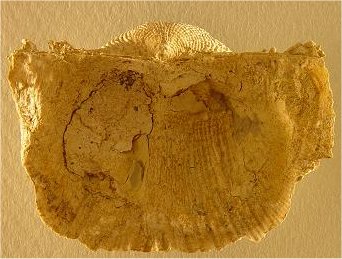
Reticulatia huecoensis
Description: "Reticulatia huecoensis" (R. E. King). This image shows the pedicle and brachial valves and the interior of a brachial valve of "Reticulatia huecoensis" (R. E. King). This species has been found in several outcrops of Hughes Creek Shale in southeastern Nebraska. This species originally described as "Productus huecoensis" R. E. King, 1931 and Dunbar and Condra described it as "Dictyoclostus americanus" in 1932. King’s name has priority and must be used. Muir-Wood and Cooper (1960) erected the genus "Reticulatia" to accommodate productoid brachiopods with a marked reticulation or net-like surface ornamentation and a long, half-round groove on the pedicle valve along which the brachial valve rotated.
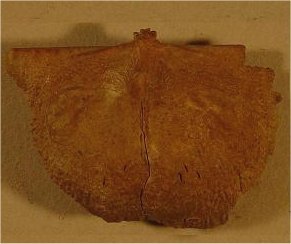
Reticulatia huecoensis
Description: "Reticulatia huecoensis" (R. E. King). This image shows the pedicle and brachial valves and the interior of a brachial valve of "Reticulatia huecoensis" (R. E. King). This species has been found in several outcrops of Hughes Creek Shale in southeastern Nebraska. This species originally described as "Productus huecoensis" R. E. King, 1931 and Dunbar and Condra described it as "Dictyoclostus americanus" in 1932. King’s name has priority and must be used. Muir-Wood and Cooper (1960) erected the genus "Reticulatia" to accommodate productoid brachiopods with a marked reticulation or net-like surface ornamentation and a long, half-round groove on the pedicle valve along which the brachial valve rotated.
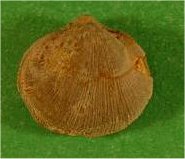
Rhipidomella carbonaria
Description: "Rhipidomella carbonaria" (Swallow) is a very long-ranging species of brachiopod that has been found in rocks ranging in age from Desmoinesian (Middle Pennsylvanian) to Wolfcampian (Early Permian). This species is commonly found in the dark, silty shale facies of the offshore shale of a cyclothem.
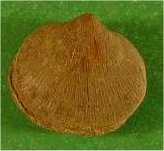
Rhipidomella carbonaria
Description: "Rhipidomella carbonaria" (Swallow) is a very long-ranging species of brachiopod that has been found in rocks ranging in age from Desmoinesian (Middle Pennsylvanian) to Wolfcampian (Early Permian). This species is commonly found in the dark, silty shale facies of the offshore shale of a cyclothem.
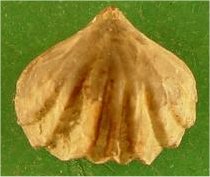
Wellerella osagensis
Description: "Wellerella osagensis" (Swallow) seems to have preferred sedimentary environments that are now manifested as calcareous shale. "W. osagensis", however, is not abundant in any of the Hughes Creek Shale exposures we have examined.
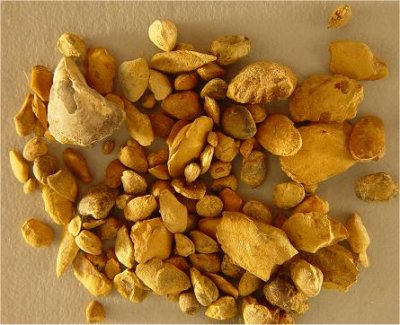
Immature Mollusk
Description: Assemblage of bivalves from the deep, cold water, dysaerobic (oxygen-deficient) transgressive facies of the lower part of the Hughes Creek. Note that these are small [the largest specimens are about ½ in (12 mm) long] and have thin, etched shells.
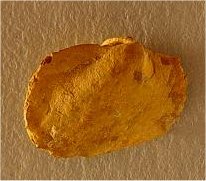
Nuculopsis?
Description: The image shows right and left valves of an immature clam that is tentatively assigned to the genus "Nuculopsis". Immature bivalves can be very difficult to identify because of homeomorphy or similar appearance. Many immature bivalves and other mollusks are commonly found in the dysaerobic, offshore facies in marine sedimentary sequences. These animals may have suffocated due to the lack of oxygen in the water column.
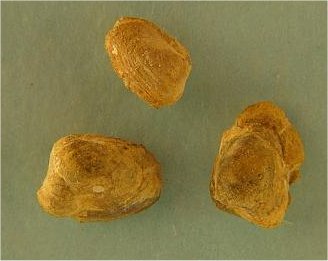
Nuculopsis?
Description: These immature specimens differ some in morphology from the "Nuculopsis?" above. These specimens are somewhat smaller and the differences may be related only to growth stages. One of the problems in paleontology is to establish growth sequences for each species wherever possible. Since the adult of a species may differ greatly in appearance from the juvenile, being able to establish growth sequences will prevent naming invalid species such as synonyms and will aid in constructing evolutionary sequences and trends in various plant and animal groups.
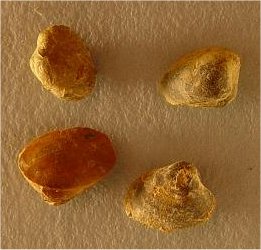
Astartella sp. cf. A. newberryi
Description: "Astartella" sp. cf. "A. newberryi" Meek is one of the more common bivalve species to be found in the Hughes Creek Shale. Its remains are almost always restricted to the offshore, dysaerobic facies in the Hughes Creek Shale.
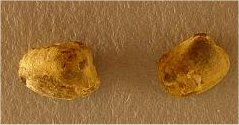
Edmondia sp. cf. E. nebrascensis
Description: "Edmondia" sp. cf. "E. nebrascensis" is compared here to Edmondia "nebrascensis" (Geinitz), one of the first invertebrate fossils to have been identified from Nebraska. The ornamentation and well-forward beak of "Edmondia nebrascensis" are characters Mudge and Yochelson (1962) used to identify this species. These examples were collected from a dyaserobic, offshore facies of the Hughes Creek.
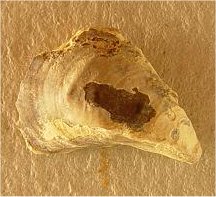
Septimyalina burmai
Description: This specimen of "Septimyalina burmai" Newell was collected from the offshore, cold-water, dyaserobic facies of the Lower Hughes Creek Shale. Note the thin shell and the etching. Length is about ½ inch (12 mm). Compare this to the thick, robust shell of "Myalina (Orthomyalina) subquadrata" (Shumard) that lived in the warmer, well-oxygenated nearshore environoments.
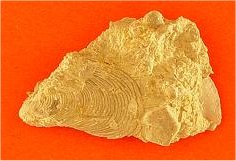
Myalina
Description: This is apparently an undescribed species of "Myalina"; it was collected by A. Allen Graffham from outcrops of Hughes Creek Shale in Lancaster County in about 1946. It was found in the nearshore facies and it may be a juvenile of "Myalina (Orthomyalina) subquadrata" (Shumard), below.
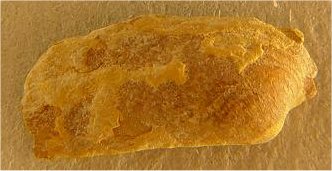
Permophorous subcostatus
Description: "Permophorous subcostatus" (Meek & Worthen). Mudge and Yochelson (1962) illustrated an example of "Permophorous subcostatus" from the younger Burr Limestone Member of the Grenola Formation in Kansas. This specimen is smaller but very similar to the one above, and is characterized by its relatively long shell and far-forward beak.
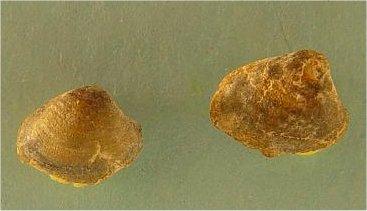
Schizodus sp. cf. S. wheeleri
Description: "Schizodus sp. cf. S. wheeleri" (Swallow). Mudge and Yochelson (1962) stated there is considerable uncertainty as to what the species "Schizodus wheeleri" (Swallow) really is because the type specimens that were described by Swallow (1863) had subsequently become lost and many specimens are internal molds that must be compared with drawings, however inaccurate, of shells. For these reasons, they only compared specimens of "Schizodus to S. wheeleri" (Swallow).
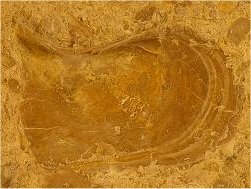
Myalina (Orthomyalina) subquadrata
Description: "Myalina (Orthomyalina) subquadrata" (Shumard). Newell (1942) pointed out that this is one of the most commonly misidentified fossil clams in the late Paleozoic of the North American Midcontinent. Newell further stated that these fossils are usually represented by a single valve, the opposite valve having been moved elsewhere by currents or wave action. Newell (1942) also stated that these clams can be very persistend and make up the "Myalina beds" in the Friedrich, French Creek, and Caneyville Formations (= Plumb Shale in Pabian & Diffendal, 1991). The Friedrich and French Creek in Nebraska are now considered members of the Root Formation (Burchett, undated). Mudge and Yochelson (1962) stated that this species may be a host to a diverse epifauna that includes algae, foraminifers, and ectoprocts (=bryozoans). Compare this large, robust specimen of "M. (Orthomyalina) subquadrata" from a shallow, nearshore environment to the small, thin shelled example of "Septimyalina burmai" Newell from a deep, offshore environment.
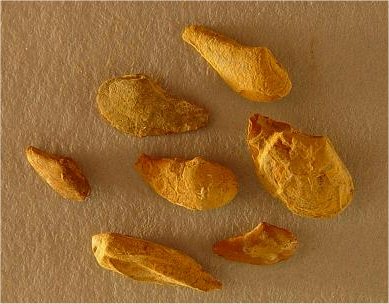
Yoldia sp. cf. Y. subscitula
Description: "Yoldia" sp. cf. "Y. subscitula" (Meek & Hayden). Mudge and Yochelson (1962) provided the first photographic ilustrations of Meek and Hayden’s type specimens of "Y. subscitula" that were probably collected from younger beds in the Chase Group in Kansas. It appears that "Y. subscitula" is a relatively small species of bivalve. The type specimens were based on internal molds and the specimens illustrated here are also internal molds. These bivalves were collected from the deep water, offshore facies of the Hughes Creek.
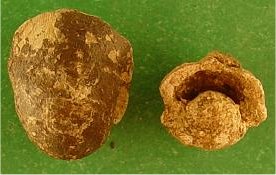
Bucanopsis
Description: Symmetric Snail - "Bucanopsis" sp. This specimen is among material that was collected before 1940 and is in the Nebraska Geological Survey invertebrate paleontological collections. There was a specific name on the label but search through the literature did not reveal that name. To use a specific name for an organism without publishing a simultaneous description creates what taxonomists (paleontologist, zoologists, botanists, etc.) call a "nomen nudum". Taxonomic (classification) rules established by the I.C.Z.N. (International Commission on Zoological Nomenclature) prohibit ever using the nomen undum again in taxonomy. Many of the symmetric gastropods had a large brim around the aperture of the shell and and this feature may have stabilized the animal in strong currents.
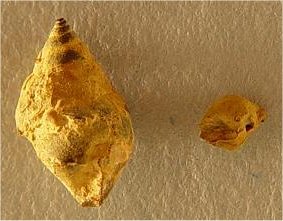
Baylea sp. cf. B. perhumerosa
Description: Medium-Spired Snail - "Baylea perhumerosa" (Meek) is a species that occurs in much older strataof late Pennsylvanian (Missourian) age, whereas "B. capertoni" (Beede) is found in much younger strata of middle to late Permian (Guadalupian) age. Late paleozoic gastropods have not been studied in great detail and this area offers many opportunities for further research in such areas as systematics, paleoecology, and biostratigraphy.
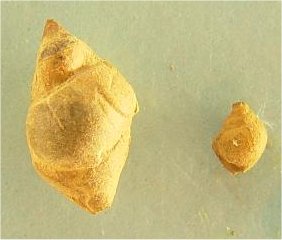
Anematina sp. cf. A. minutissima
Description: High-Spired Snail - "Anematina minutissima" (Knight) was originally described from middle Pennsylvanian (Desmoinesian) strata from the Mississippi Valley. The shell of this species is generally smooth and it appears to be a long-ranging form.
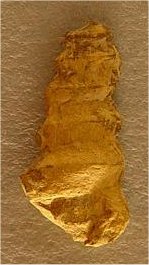
Murchisonia sp. cf. M. gouldii
Description: High-Spired Snail - "Murchisonia gouldii" Beede was originally described from much younger middle to late Permian (Guadalupian) strata in the southwestern United States. The illustrated example here closely resembles examples illustrated in Shimer and Shrock (1944) and it is compared to them but not actually assigned to that species.
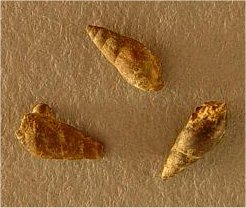
Palaeostylus?
Description: High-Spired Snail - This specimen closely resembles any of several species that have been assigned to the genus "Palaeostylus". It is assigned to "Palaeostylus" with some reservations.
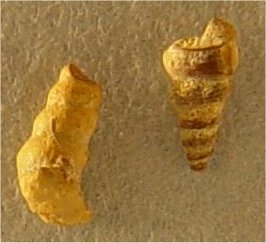
Palaeostylys (Pseudozygopleura) sp. cf. P. (Pseudozygopleura) schucherti
Description: High-Spired Snail - "Palaeostylys (Pseudozygopleura)" sp. Cf. "P. (Pseudozygopleura) schucherti" (Knight). The genus "Palaeostylus" contains several sub-genera, and "Pseudozygopleura" is rather common in the North American Mid-continent. This genus may be rather long-ranging, the earliest species appearing in the Mississippian of the mid-continent.
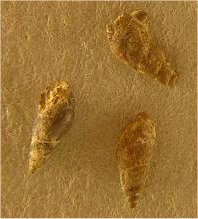
Soleniscus sp. cf. S. typicus
Description: High-Spired Snail - "Soleniscus" sp. Cf. "S. typicus" (Meek & Worthen). "Soleniscus" is a long ranging genus (Mississippian through Permian) in the mid-continent. Most of the examples found in Nebraska probably belong to the species "S. typicus" Meek & Worthen,
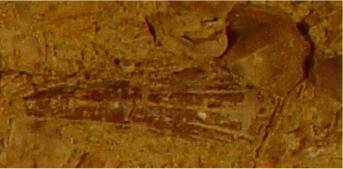
Dentalium
Description: "Dentalium" sp. This example of scaphopod is the only one that has been found in the Hughes Creek Shale. It is very similar to one recorded by Mudge and Yochelson (1962) from the Friedrich Shale Member of the Root Formation. Except for being rare, scaphopods do not make up an important part of the Hughes Creek fauna.
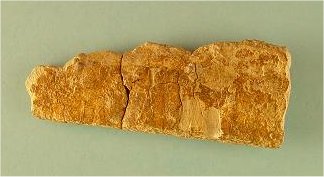
Dolorthoceras sp. cf. D. ciscoense
Description: "Dolorthoceras" sp. cf. "D. ciscoense" (Miller, Dunbar and Condra). Miller, Dunbar and Condra (1933) recorded this species from near Cisco, north of Brownwood, Texas, and they stated that only one specimen was known from Nebraska although others were in the invertebrate fossil collections of the Yale Peabody Museum, New Haven, Connecticut. The type species for the genus "Colorthoceras, D. circulare" Miller was found in strata of upper Pennsylvanian (Zone of Schistoceras) shale near Woabjilga, Aghil-Depsang or Central Ranges north of Karakoram and south of the K’un-lun Mountains of central Asia.
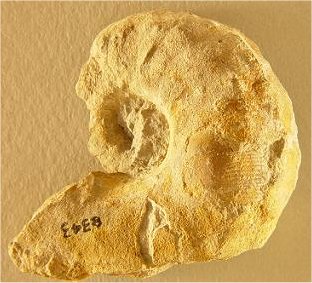
Metacoceras sp. cf. M. sublaeve
Description: "Metacoceras" sp. cf. "M. sublaeve" (Miller, Dunbar, & Condra). "Metacoceras" is a very long-ranging genus of Nautiloid from the Pennsylvanian-Permian section of North America. There are several species, some of which have been found as far east as West Virginia. Miller, Dunbar and Condra described the holotype specimen of "Metacoceras sublaeve" from six examples that were collected from the Neva Limestone Member of the Grenola Formation in Lancaster County. The specimen illustrated here is from a horizon that is in closest vertical proximity to the horizon from which the holotype of "M. sublaeve" was collected and is only compared to it. Because of relatively poor preservation of septa between the chambers, this specimen can only be compared to a previously described species.
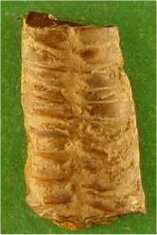
?Bactrites
Description: Order Bactritida Shimansky, 1951, Bactritoids? "Bactrites" sp.
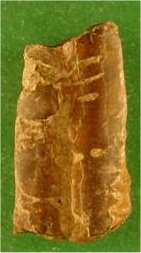
?Bactrites
Description: Order Bactritida Shimansky, 1951, Bactritoids? "Bactrites" sp.
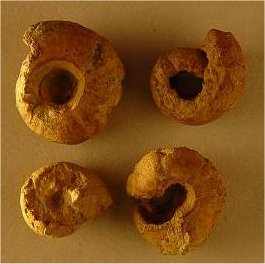
Immature Goniatites
Description: Immature Goniatites, greatest diameter about 10 mm.
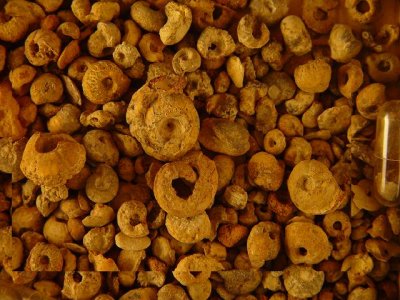
Immature Goniatites
Description: Order Ammonoidea. Immature Goniatites, diameters range from about 2 mm to 15 mm. This large group of immature goniatites may have all perished in oxygen-deficient water. Such assemblages of goniatites are commonly found in such environments where upwelling currents of dysaerobic waters cause mass mortality by suffocation. Holterhoff and Pabian (1989) citing written communication from B. F. Glensiter stated that the goniatite fauna from the Hughes Creek Shale included "Eoasianites" sp., "Prothalossoceras" sp., and "Mescalites discoidale" (Bose). Furnish and Glenister (1971) named the genus Mescalites from material that Bose had originally described as "Gonioloboceras discoidale", and which was collected from strata of lower Permian age near Tularosa, New Mexico. An immature "M. discoidale" was found among these juvenile specimens.
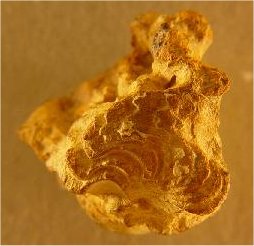
Immature Goniatites
Description: Order Ammonoidea. "Prothallosoceras" sp., shell of mature individual showing the typical goniatite suture. This individual was found among a collection of immature goniatites. This is one of the few mature ammonoids that was collected from the Hughes Creek Shale in Nebraska.
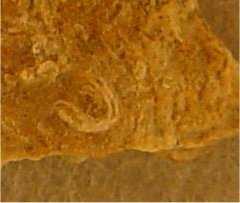
Serpulopsis sp. cf. S. insita
Description: "Serpulopsis" sp. cf. "S. insita" (White). "Serpulopsis" is the small, often twisted and tortuous tube of an annelid worm that was not host specific. "Serpulopsis" may be found either free or attached to many different kinds of invertebrates including crinoid stems and plates, brachiopods, mollusks, and to any hard object that may have furnished a firm substrate.
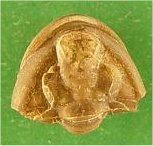
Ditomopyge scitula
Description: "Ditomopyge scitula" (Meek and Worthen). Images 79 and 80 are Cephalic (head) and tygidial (tail) views. "Ditomopyge scitula" (Meek & Worthen) is a long-ranging trilobite that has been found in almost all of the marine fossil-bearing Pennsylvanian and Permian rocks in Nebraska and the North American Midcontinent. Pabian (1970) Pabian and Fagerstrom (1972) recorded this species from many outcrops in southeastern Nebraska and Pabian, Borovich and Mapes (1993) constructed a growth series for this species that showed morphologic changes in the cephalons and pygidia of this species throughout its development.
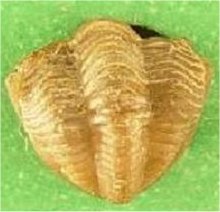
Ditomopyge scitula
Description: "Ditomopyge scitula" (Meek and Worthen). Images 79 and 80 are Cephalic (head) and tygidial (tail) views. "Ditomopyge scitula" (Meek & Worthen) is a long-ranging trilobite that has been found in almost all of the marine fossil-bearing Pennsylvanian and Permian rocks in Nebraska and the North American Midcontinent. Pabian (1970) Pabian and Fagerstrom (1972) recorded this species from many outcrops in southeastern Nebraska and Pabian, Borovich and Mapes (1993) constructed a growth series for this species that showed morphologic changes in the cephalons and pygidia of this species throughout its development.
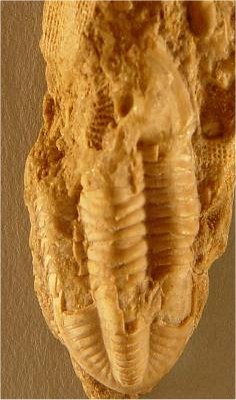
Undescribed genus and species
Description: Class Trilobita, Trilobites. Undescribed genus and species. Unfortunately, the cephalon or head of this trilobite is damaged in such a way that it is impossible to view any diagnostic features. The small number of segements in the pygidium or tail suggest that it probably belongs to a genus that has not yet been described.
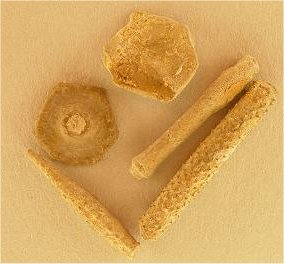
Echinocrinus sp. cf. E. aculeata
Description: Class Echinoidea, Echinoids, Sea Urchins. "Echinocrinus" sp. cf. "E. aculeata" (Shumard & Swallow). Late Paleozoic echinoids were very fragile and disintegrated almost immediately after death. Unless the animal underwent extremely quick burial, its remains will not be found intact, although several complete examples have been found in older rocks Pennsylvanian rocks in Nebraska. Echinoids are usually represented by interambulacral plates and ornamented spines (illustrated here), lantern rays, and teeth.
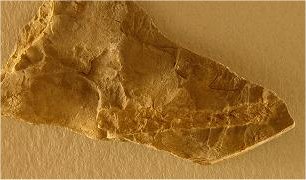
Archeophiomusium sp. cf. A. burrissi
Description: Class Ophiuroidea, Brittle Stars. "Archeophiomusium" sp. cf. "A. burrissi" (Miller). Ophiuroids are very rare fossils and the remains of only two other more or less complete specimens from Nebraska and Iowa have been documented from the older late Pennsylvanian strata by Pabian and Strimple (1973). This more or less complete brittle star was found in the Hughes Creek Shale in Lancaster County. H. W. Miller, Jr., first described the species A. burrissi as "Ophiuraster burrissi" Miller from the Permian of Kansas. It was later determined that the genus name "Ophiuraster" was preoccupied by examples named by Clark (1939) and the species was placed in the genus "Ophiomusium Lyman" with some reservations. Subsequent collections of ophiuroid specimens led Hattin (1967)to erect a new genus "Archeophiomusium" to accommodate this species. This example well illustrates the self-correcting nature of scientific research.
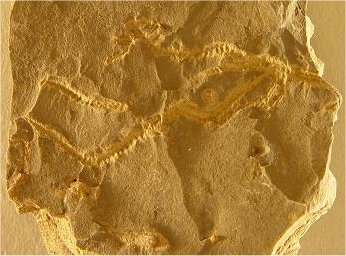
Archeophiomusium sp. cf. A. burrissi
Description: Class Ophiuroidea, Brittle Stars. "Archeophiomusium" sp. cf. "A. burrissi" (Miller). Ophiuroids are very rare fossils and the remains of only two other more or less complete specimens from Nebraska and Iowa have been documented from the older late Pennsylvanian strata by Pabian and Strimple (1973). This more or less complete brittle star was found in the Hughes Creek Shale in Lancaster County. H. W. Miller, Jr., first described the species A. burrissi as "Ophiuraster burrissi" Miller from the Permian of Kansas. It was later determined that the genus name "Ophiuraster" was preoccupied by examples named by Clark (1939) and the species was placed in the genus "Ophiomusium Lyman" with some reservations. Subsequent collections of ophiuroid specimens led Hattin (1967)to erect a new genus "Archeophiomusium" to accommodate this species. This example well illustrates the self-correcting nature of scientific research.
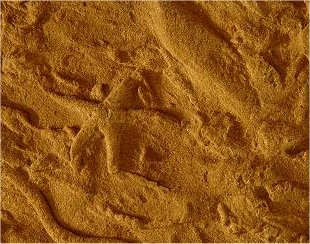
Ichnogenus Asteriacites
Description: Class Stelleroides, Star Fish. Ichnogenus "Asteriacites" (von Schlotheim) 1820 . Undetermined starfish resting traces of starfishes have been found in some of the late Paleozoic rocks of the midcontinent.
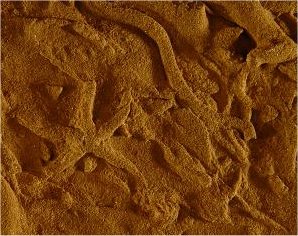
Ichnogenus Asteriacites
Description: Class Stelleroides, Star Fish. Ichnogenus "Asteriacites" (von Schlotheim) 1820 . Undetermined starfish resting traces of starfishes have been found in some of the late Paleozoic rocks of the midcontinent.
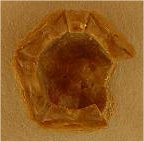
Graffhamicrinus boellstorffi
Description: Class Crinoidea, Sea Lilies.. "Graffhamicrinus boellstorffi" Pabian & Strimple (holotype). Dorsal cup, summit and basal views are in images 88 and 89. This is the holotype specimen, the one on which the species was originally based. It was collected from the upper part of the Hughes Creek Shale on outcrops in Nemaha County. The species was originally described by Pabian and Strimple (1974) but Pabian and Rushlau (2002) called attention to encrustations of serpulid worms on the cup.
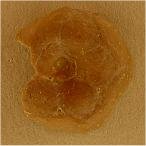
Graffhamicrinus boellstorffi
Description: Class Crinoidea, Sea Lilies.. "Graffhamicrinus boellstorffi" Pabian & Strimple (holotype). Dorsal cup, summit and basal views are in images 88 and 89. This is the holotype specimen, the one on which the species was originally based. It was collected from the upper part of the Hughes Creek Shale on outcrops in Nemaha County. The species was originally described by Pabian and Strimple (1974) but Pabian and Rushlau (2002) called attention to encrustations of serpulid worms on the cup.
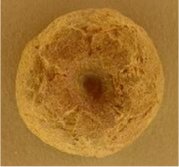
Graffhamicrinus boellstorffi
Description: Class Crinoidea, Sea Lilies. "Graffhamicrinus boellstorffi" (Pabian & Strimple). Dorsal cup, summit and basal views are in images 90 and 91. This is a hypotype specimen---one that was collected from an outcrop of Hughes Creek shale in Richardson county, about 40 miles from where the holotype specimen was collected. This example was collected by Bill Rushlau and has subsequently been recorded by Pabian and Rushlau (2002) who called atttention to the algae coating and probably sponge borings through the surface of the cup.

Graffhamicrinus boellstorffi
Description: Class Crinoidea, Sea Lilies. "Graffhamicrinus boellstorffi" (Pabian & Strimple). Dorsal cup, summit and basal views are in images 90 and 91. This is a hypotype specimen---one that was collected from an outcrop of Hughes Creek shale in Richardson county, about 40 miles from where the holotype specimen was collected. This example was collected by Bill Rushlau and has subsequently been recorded by Pabian and Rushlau (2002) who called atttention to the algae coating and probably sponge borings through the surface of the cup.
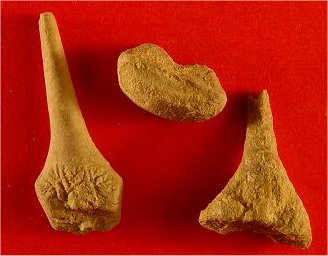
?Plaxocrinus
Description: Class Crinoidea, Sea Lilies. "?Plaxocrinus sp." From left to right, sac spine, radial and primibrachial plate from large pirasocrinis, probably Plaxocrinus. Sac spine is about 1 in (25 mm) long. The sac spines formed the "ribs" of a large umbrella that sat atop the distal end of the anal sac of the crinoid. The spines may have warded off coprophytic gastropods or they may have served as a baffle to slow food bearing water currents, as suggested by Lewis (1979). Although remains of "Plaxocrinus" and other similar pirasocrinids are fairly common in the Hughes Creek Shale, no cups or crowns of these forms have yet been recovered in Nebraska.
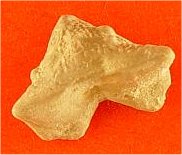
?Synarmocrinus
Description: Class Crinoidea, Sea Lilies. "?Synarmocrinus" sp. "Synarmocrinus" was named by Lane (1964) for material that was collected from early Permisn strata in Nevada. The genus belongs to a family of crinoids called the Cromyocrinidae, that are usually large, robust forms that preferred well-oxygenated, shallow, warm water that characterized the nearshore facies in the cyclothemic deposits. Images 93 and 94 show proximal and distal views of a primibrachial (first arm) plate that connected immediately to the radial plate on the cup below. Cromyocrinid parts, like the pirasocrinid parts above, are fairly common in the Hughes Creek, but no cups or crowns of them have been collected from that unit in Nebraska so far.
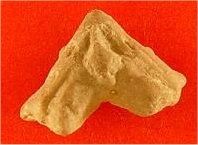
?Synarmocrinus
Description: Class Crinoidea, Sea Lilies. "?Synarmocrinus" sp. "Synarmocrinus" was named by Lane (1964) for material that was collected from early Permisn strata in Nevada. The genus belongs to a family of crinoids called the Cromyocrinidae, that are usually large, robust forms that preferred well-oxygenated, shallow, warm water that characterized the nearshore facies in the cyclothemic deposits. Images 93 and 94 show proximal and distal views of a primibrachial (first arm) plate that connected immediately to the radial plate on the cup below. Cromyocrinid parts, like the pirasocrinid parts above, are fairly common in the Hughes Creek, but no cups or crowns of them have been collected from that unit in Nebraska so far.
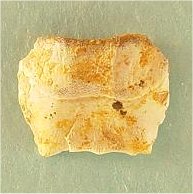
Janassa
Description: Shark tooth, "Janassa" sp. Shark teeth have proved to be rare in the Hughes Creek and this single tooth that resembles Malzahn’s (1968) illustrated examples of Janassa is one of but two examples of fish remains that have been found in the Hughes Creek to date.
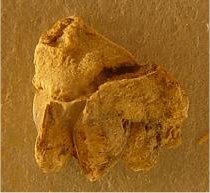
Symphysial dentition
Description: Symphysial dentition form unidentified Permian shark or shark-like fish. Symphysial dentition is made up of the whorl of bilaterally symmetric teeth that are situated on the plane of symmetry of the fish’s mouth. That these teeth have no cutting edge suggests that they may have been from a small shark that fed on plankton.
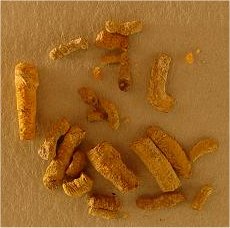
Arenicolites
Description: "Arenicolites" is an ichnogenus that is represented by U-shaped burrows when the fossil is complete. Note the example in the center of the image that has one of the twists for half of the U. These fossils are commonly found only in the offshore, dysaerobic facies of the Hughes Creek.
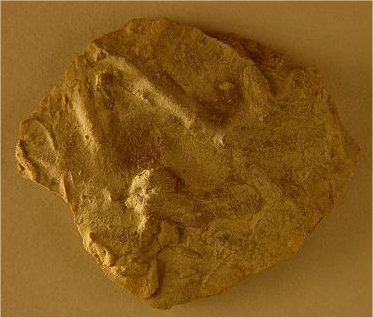
Cruziana d’Orbigny
Description: "Cruziana d’Orbigny". These burrows have meniscus structures in them and resemble a form that Hakes (1976) referred to as "Cruziana d’Orbigny". These forms have been found mostly in the offshore, dyaserobic facies of the Hughes Creek.
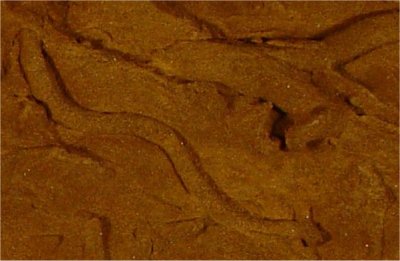
Burrows
Description: This example shows a branching burrow and a meandering trail. The slab from which these fossils are illustrated contains numerous traces including Asteriacites above. These traces are from the nearshore, sandy facies of the Hughes Creek.
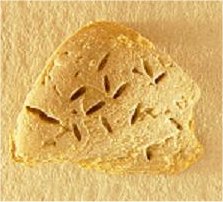
Trypetesa caveata
Description: "Trypetesa caveata" [Tomlinson] (1963). Tomlinson (1963) named this kind of boring "Trypetesa caveata" and attributed it to acrothoracican barnacles and assigned his species to an extant genus, "Trypetesa". These kinds of borings are commonly observed on Myalinid bivalves, as in this specimen, and crinoids. Seilacher (1969) suggested this kind of boring was made by a polydorid worm.
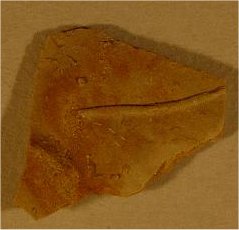
Wormtube
Description: This meandering trail was collected from the offshore, dyaserobic facies of the Hughes Creek Shale. It is much smaller than the trails from the well-oxygenated, nearshore facies of the Hughes Creek.
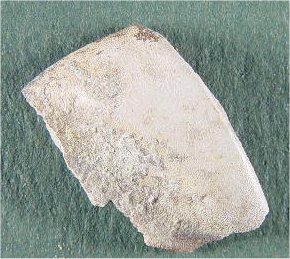
Platyxystrodus tooth
Description: Pavement tooth or shell crushing tooth from shark- or ray-like fish, "Platyxyxtrodus" sp. collected from near Humboldt, Nebraska. Length about 1 inch (2.5 cm).
Exposures

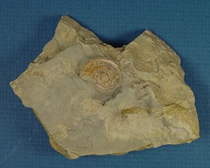
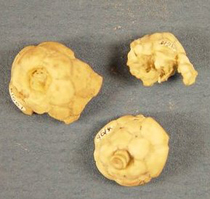
References
The fossils shown in this page have been collected over a long span of time by both professional geologists and amateur collectors: Professional geologists include Erwin Hinkley Barbour, C. Bertrand Schultz, T. Mylan Stout, George Evert Condra, Maxim K. Elias, John Boellstorff, Peter F. Holterhoff, and A. Allen Graffham. Amateur collectors include W. D. "Ted" White, Bill Rushlau, Barry Sutton, and Mark Van Heel. This page would have not been possible without their contributions.
- Burchett, R. R., undated, Composite section of outcropping rocks along the Missouri River Bluffs in southeastern Nebraska & adjacent areas: Nebraska Geological Survey, Conservation & Survey Division, University of Nebraska-Lincoln.
- Condra, G. E., 1903, The Coal Measure Bryozoa of Nebraska: Nebraska Geological Survey, v. II, pt. one, 168 p.
- -----, 1927, The Stratigraphy of the Pennsylvanian System in Nebraska: Nebraska Geological Survey, Bull. 1, 2nd Series, 292 p.
- -----, Condra, G. E., and Reed, E. C., 1959, The Geological Section of Nebraska: [Revised by E. C. Reed], Conservation and Survey Division, University of Nebraska, Nebraska Geological Survey Bulletin 14a, 82 p.
- Cooper, G. A., 1957, Brachiopods: in Ladd, H. S., (editor), Treatise on Marine Ecology and Paleoecology, Geological Society of America Memoir 67, p, 801-804.
- Furnish, W. M., and Glenister, B. F., 1971, Permian Gonoloboceratidae (Ammonoidea), in Dutro, J. T., Jr., (editor) Paleozoic Perspectives; A Paleontological Tribute to G. Arthur Cooper: Smithsonian Contributions to Paleobiology, Number 3, p. 301-312.
- Hakes, W. G., 1976, Trace fossils and depositional environment of four clastic units, Upper Pennsylvanian megacyclothems, northeast Kansas: University of Pansas Paleontological Contributions, Article 63, 46 p.
- Hattin, D. E., 1967, Permian ophiuroids from northern Oklahoma: Journal of Paleontology, v. 41, p. 489-492.
- Heald, K. C., 1916, The oil and gas geology of the Foraker Quadrangle, Oklahoma: U. S. Geological Survey, Bulletin 641-B, p. 17-47.
- Holterhoff, P. F., and Pabian, R. K., 1989a, Paleoenvironmental implications of a pyritized molluscan fauna from the Bennett shale Member, Red Eagle Formation (Lower Permian), Richardson County, Nebraska: The Compass of Sigma Gamma Epsilon, v. 67, ho. 1, p. 35-47.
- -----, 1989b, Stop 16: Roadcut about 8 mi. south of Humboldt: In Pabian, R. K., and Diffendal, R. F., Jr., (compilers) Late Pennsylvanian and Early Permian Cyclic Sedimentation, Paleogeography, Paleoecology, and Biostratigraphy, in Kansas and Nebraska: Guidebood for a pre-meeting field trip in conjunction with the 1989 annual meeting of the Geological Society of America, St. Louis, Missouri, November 6-9, 1989; Nebraska Geological Survey, Conservation and Survey Division, Institute of Agriculture and Natural Resources, University of Nebraska-Lincoln, 75 p.
- Kirk, M. Z., 1896, A geologic section along the Neosho and Cottonwood Rivers : Kansas University Geological Survey, v. 1, p. 72-85.
- Kohn, A. J., 1985, Gastropod Paleoecology: In.Broadhead, T. W. (editor), Mollusks, notes for a short course, orgnaized by D. J. Bottjer, C. S. Hickman, P. D. Ward, University of Tennessee Department of Geological Sciences, Studies in Geology 13, prepared for the Short Course on Mollusks sponsored by the Paleontological Society, October 27, 1985, 305 p.
- Lutz-Garihan, A. B., 1976, Composita subtilita (Brachiopoda) in the Wreford Megacyclothem (Lower Permian) in Nebraska, Kansas, and Oklahoma: University of Kansas Paleontological Contributions, Paper 81, 19 p.
- Mapes, R., 1979, Carboniferous and Permian Bactritoidea (CEPHALOPODA) in North America; University of Kansas Paleontological Contributions, Article 64, University of Kansas Paleontological Institute, University of Kansas, Lawrence, 75 p.
- Miller, A. K., Dunbar, C. O., and Condra, G. E., 1933, The Nautiloid Cephalopods of the Pennsylvanian System in the Mid-continent Region: Nebraska Geological Survey, Bulletin 9, Second Series, 240 p.
- Miller, H. W., Jr., 1958, A new genus and species of Permian ophiuroid from Kansas: Journal of Paaleontology, v. 32, p. 357-361.
- -----, 1963, Ophiuraster Miller 1958 preoccupied by Ophiuraster Clark 1939: Journal of Paleontology, v. 37, p. 725.
- Moore, R. C., and Jeffords, R. M., 1941, New Permian Corals from Kansas, Oklahoma, and Texas: State Geological Survey of Kansas, Bulletin 38, pt. 3, p. 65-120.
- Mudge, M. R., and Yochelson, E. L., 1962, Stratigraphy and Paleontology of the Uppermost Pennsylvanian and Lowermost Permian Rocks in Kansas: U.S. Geological Survey, Professional Paper 323, 213 p.
- Newell, N. D., 1942, Late Paleozoic Pelecypods: Mytilacea: University of Kansas Publications, State Geological Survey of Kansas, v. 10, part 2, 80 p.
- Pabian, R. K., Borovich, J., and Mapes, R. H., 1993, Growth Stages of the Middle and Late Pennsylvanian Trilobite Ditomopyge scitula from the North American Midcontinent: Journal of Paleonotlogy, v. 67, no 2., p. 230-240.
- Pabian, R. K., and Diffendal, R. F., Jr., 1991, Late Paleozoic Cyclic Sedimentation in Southeastern Nebraska: a Field Guide: Conservation & Survey Division, IANR, University of Nebraska-Lincoln, Educational Circular No. 9, 64 p.
- Pabian, R. K., and Fagerstrom, J. A., 1972, Late Paleozoic trilobites from southeastern Nebraska: Journal of Paleontology, v. 41, p. 789-816.
- Pabian, R. K., and Strimple, H. L., 1973, A Pennsylvanian Ophiuroid from Southwestern Iowa: Iowa Academy of Science, Proceedings, Spring Meeting, 2 p.
- Rudwick, M. J. S., 1965, Ecology and Paleoecology: in Moore, R. C., editor, Treatise on Invertebrate Paleontology, (H) Brachiopoda(1), Geological Society of America and University of Kansas Press, p. 199-214.
- Seilacher, A., 1969, Paleoecology of boring barnacles: American Zoologist, v. 9, p. 705-719
- Tomlinson, 1963, Acrothoracican barnacles in Paleozoic Myalinids: Journal of Paleontology, v. 37, p. 164-166.
- White, C. A., and St. John, O. H., 1867, Description of new Subcarboniferous and coal measure fossils collected upon the geological survey of Iowa, together with a notice of new generic character observed in two species of brachiopods: Academy of Sciences of Chicago Transactions, v. 1, p. 115-127.
- Williams, A., 1956, The calcareous shell of the Brachiopoda and its importance in their classification: Biological Reviews, v. 31, p 243-287.